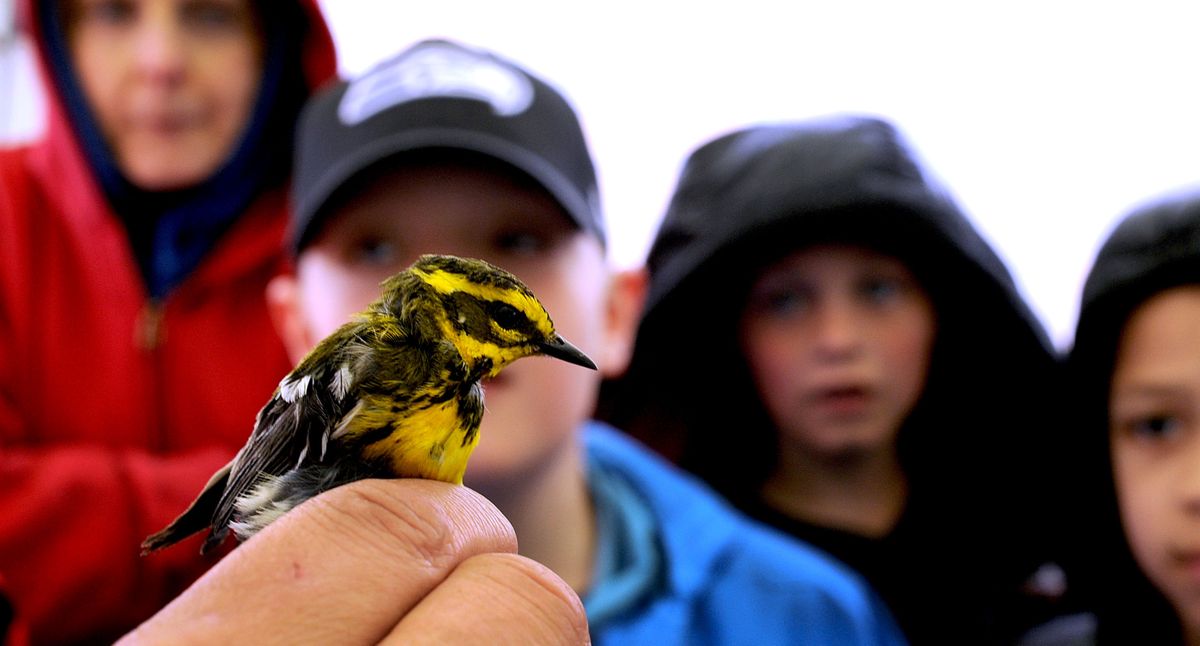Feds weighing songbirds’ health in mine waste area

Townsend’s warblers are showy lightweights.
Each of the tiny birds sports a dark crown, jaunty yellow chest and a weight comparable to a Hershey’s chocolate kiss. They’re mostly seen in brief flashes through tree branches, unless you’re lucky enough to be a second-grader on a U.S. Fish and Wildlife Service field trip.
The students leaned in to inspect the Townsend’s warbler in Roy Brazzle’s hand. It was captured Tuesday morning in a mist net along the North Fork of the Coeur d’Alene River.
Second-graders from Skyway Elementary School in Coeur d’Alene are visiting the site in field trips paid for by a Fish and Wildlife Service “Connecting People with Nature” grant.
Brazzle, a former Fish and Wildlife Service employee, weighed the warbler, talked about why researchers band birds for studies and showed the students how to look for brood patches on females. The liquid-filled pouch helps mother birds incubate eggs and keep babies warm.
Migratory songbirds in the Coeur d’Alene River basin are a current research focus for the Fish and Wildlife Service. Just downstream from the field trip site, biologists are capturing songbirds as part of ongoing studies into how lead affects wildlife in the basin, said Kate Healy, a USFWS biologist.
After the demonstration, Brazzle set the warbler on Mike Hall’s palm, so the second-grader could release it.
“It felt soft,” said Hall, wonder in his voice.
“There’s nothing like holding a bird in your hand – you just feel like you’re going to break it,” said Brian Spears, a USFWS contaminants specialist. “Then you realize how amazing they are, that they fly to South America for the winter. They’re just little puffballs.”
Over the past century, about 100 million tons of mining waste from Idaho’s Silver Valley has washed into the Coeur d’Alene River system. Ground-feeding birds such as robins, song sparrows and Swainson’s thrush ingest lead from the waste while they’re foraging for worms and insects.
Biologists are studying ground-feeding songbirds captured at Smelterville Flats, a highly polluted area along the South Fork of the Coeur d’Alene River, alongside songbirds captured near the North Fork, where little mining occurred. By collecting blood, liver and gut samples, the biologists will compare blood-lead levels and rates of anemia in the two populations. They’ll also study reproductive success at the two locations.
Songbirds that forage in highly contaminated areas have higher blood lead levels, research has found.
At Smelterville Flats, the soil’s lead levels range from 1,000 to 3,000 parts per million, well above the safe threshold for songbirds of 530 parts per million.
“Are they dying? We don’t know,” Healy said. “There’s no way we’ll find little dead birds in the woods. They get eaten too fast, and they blend right in.”
But since songbirds return to the same nesting areas, the researchers will be able to track population trends. This is the second year of the study, which will continue for five years. Over time, the results will help measure how effective the mine waste cleanup projects are for songbirds.
“At the U.S. Fish and Wildlife Service, part of our job is to make sure that wildlife in the United States is happy and healthy,” Spears told the kids.